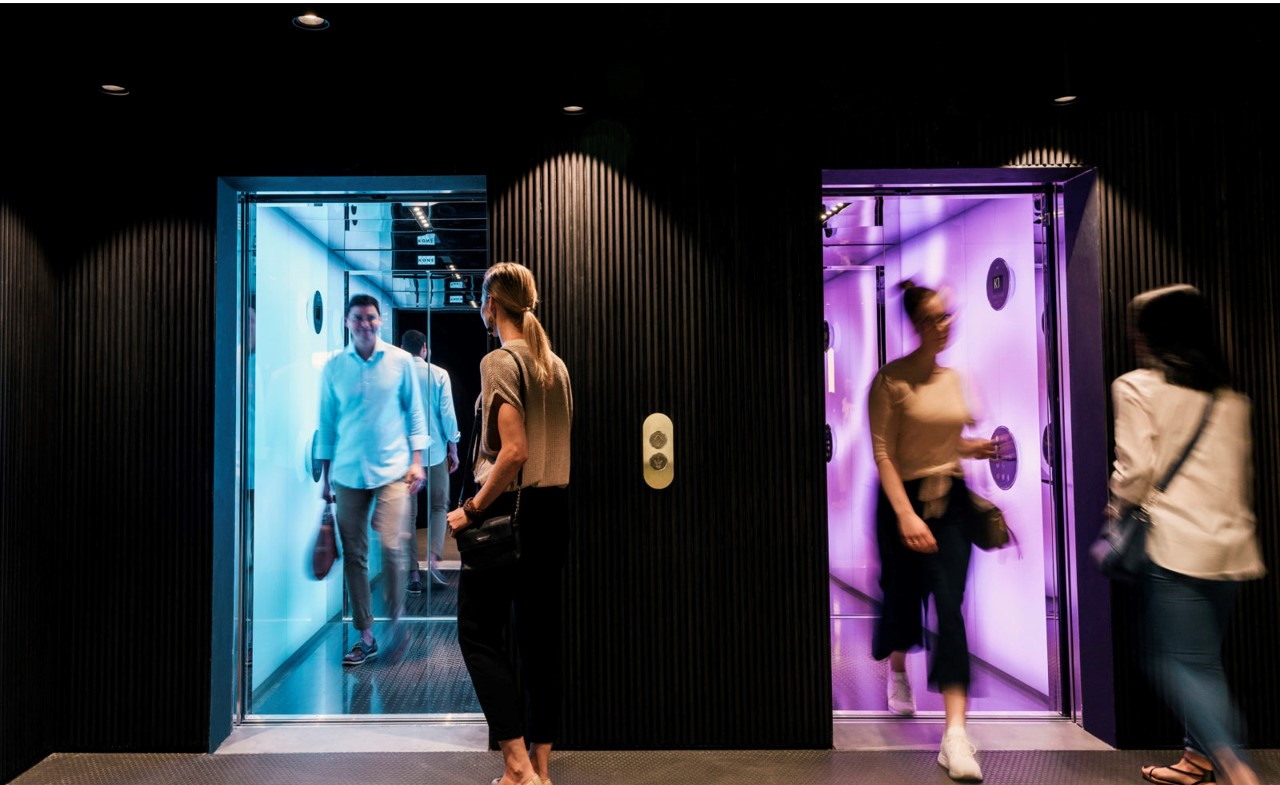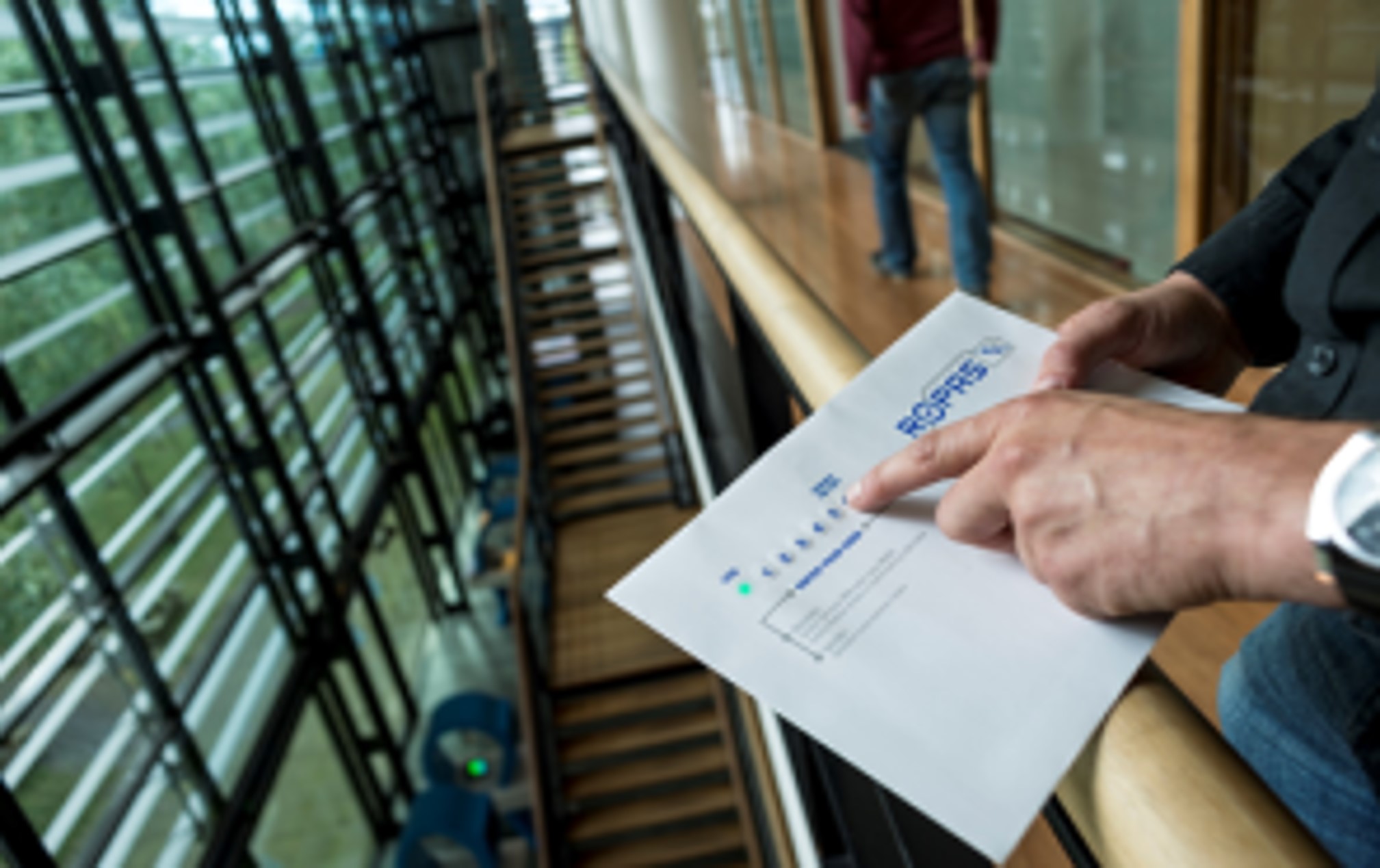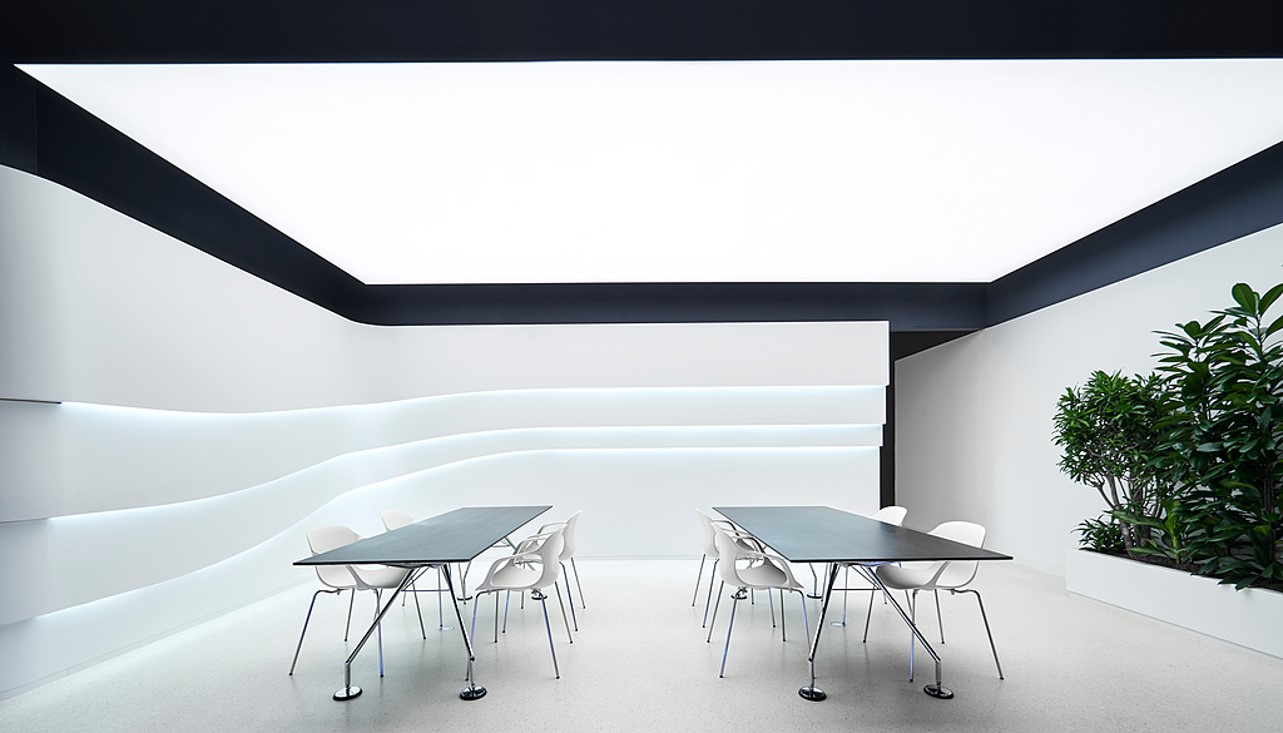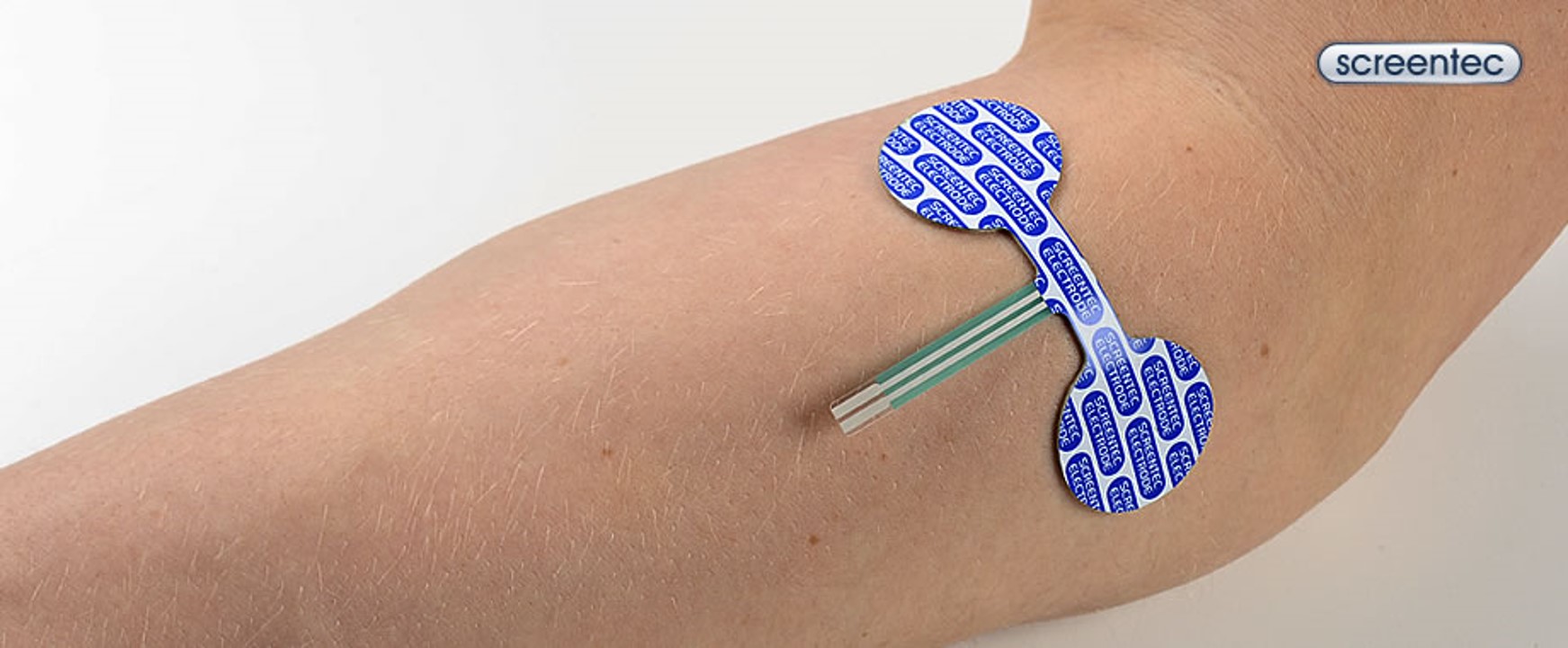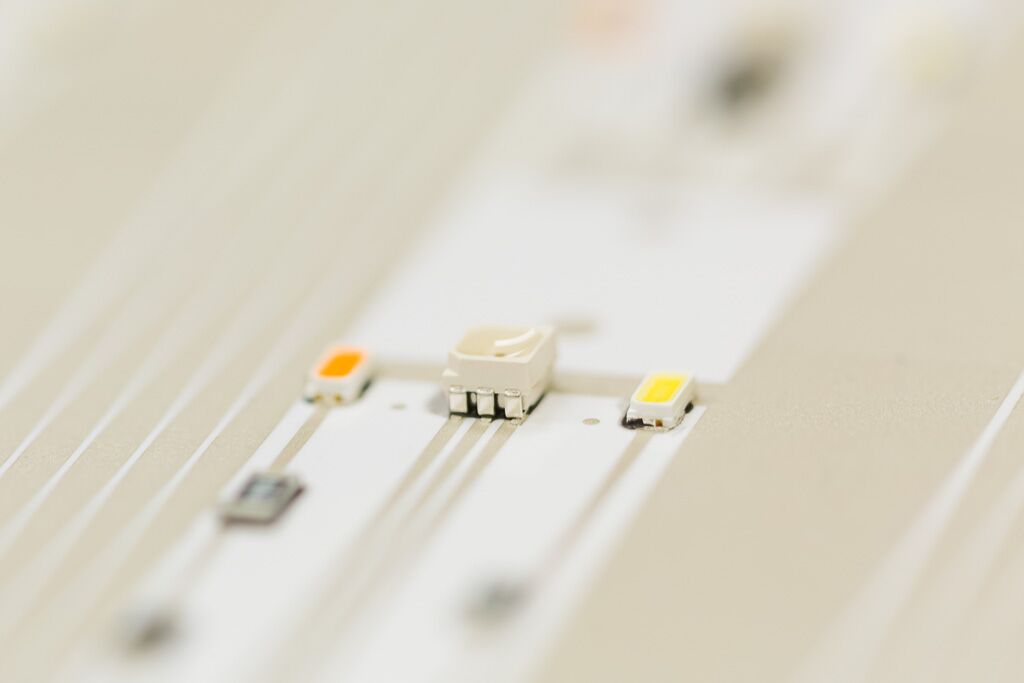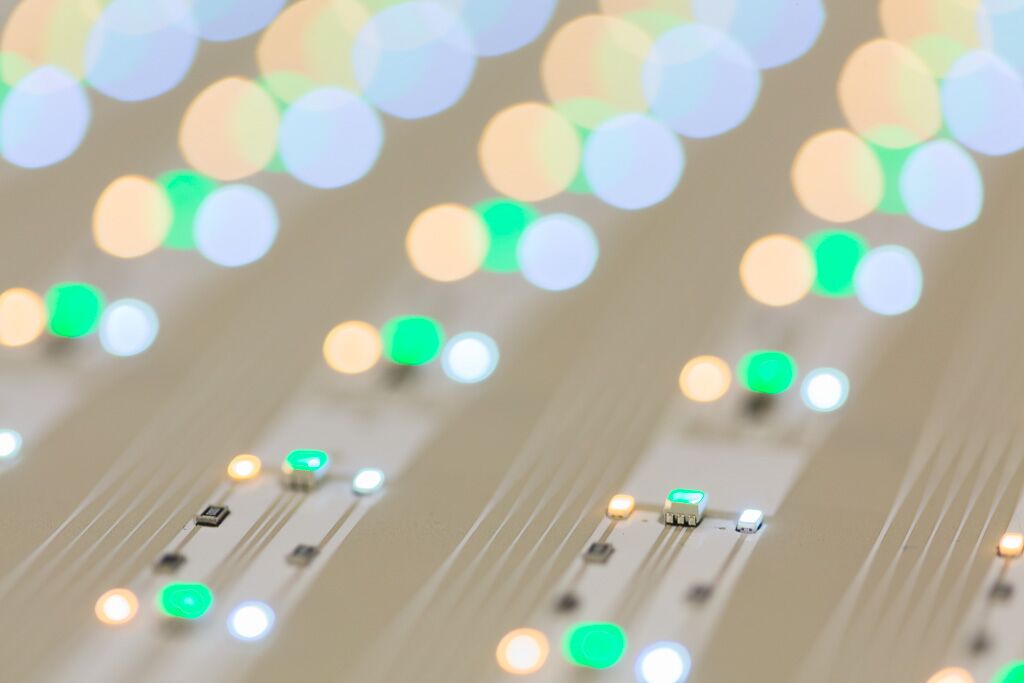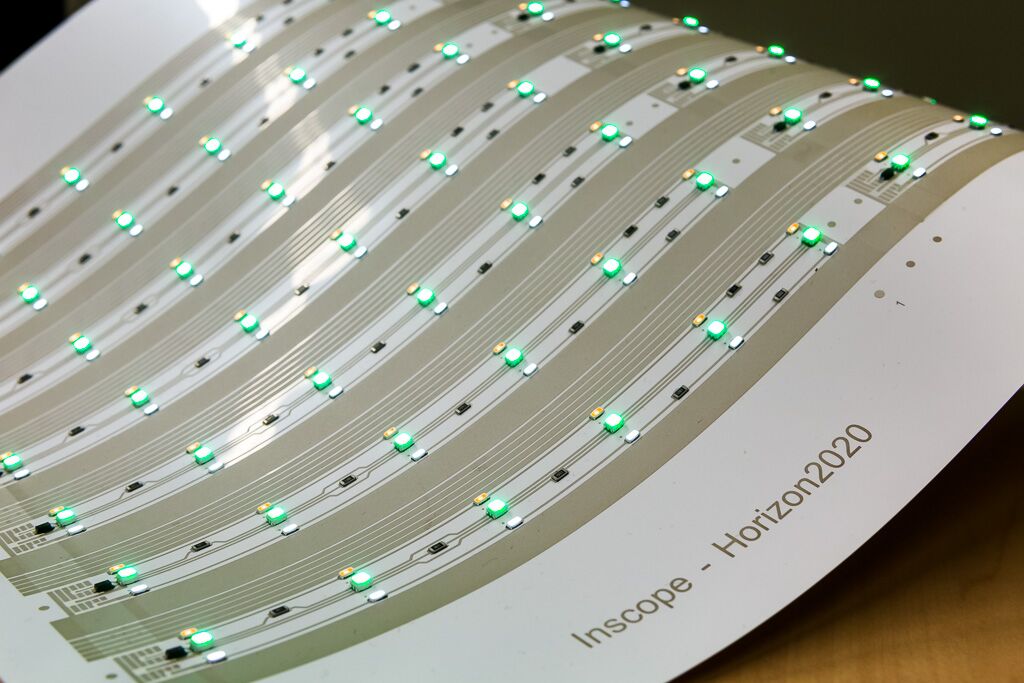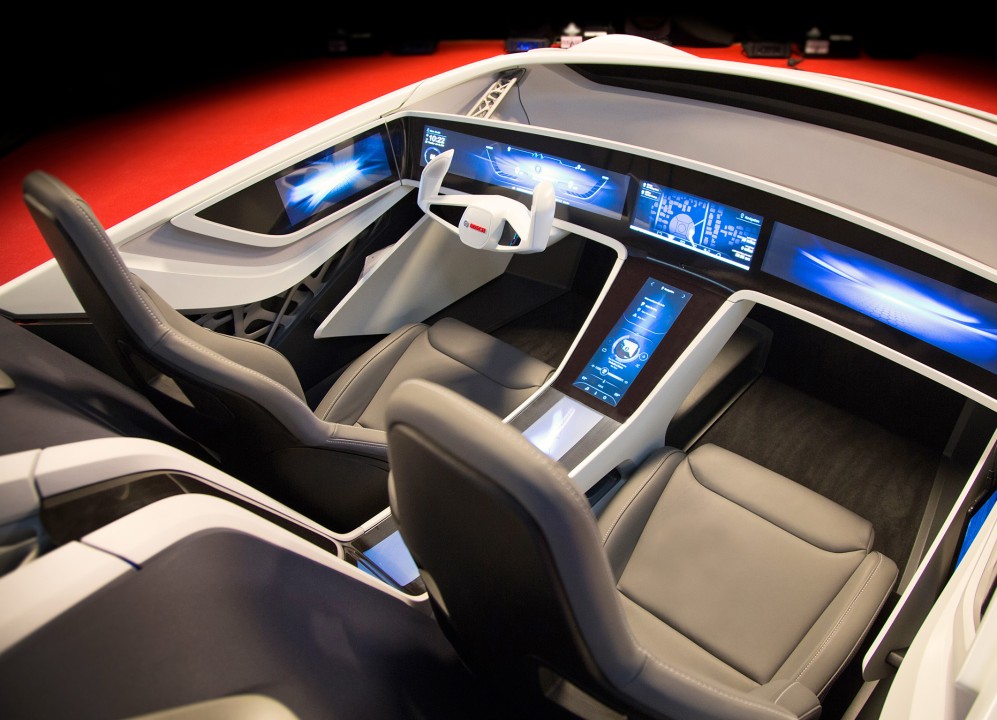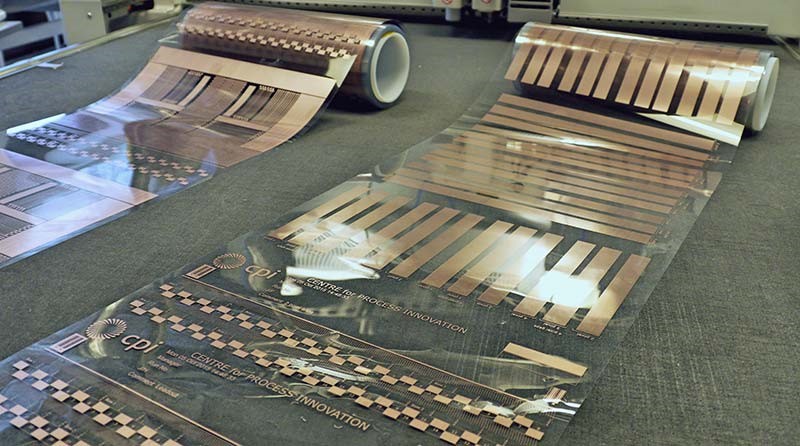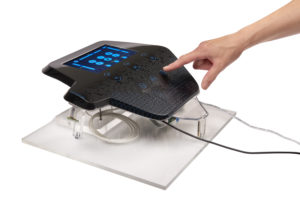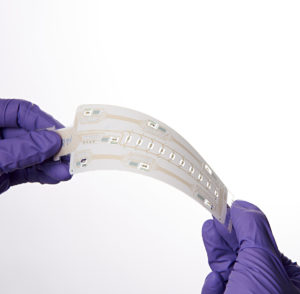Signify
Smart lighting – Product idea
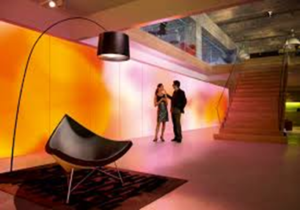 Smart lighting solution for living and urban spaces. From setting the scene for a perfect night to creating a work environment of the future, LED foils will soon establish the golden standard for energy efficient house and office illumination that keeps user comfort at the heart of its design. InSCOPE bridges the gap between idea and reality producing the following impact:
Smart lighting solution for living and urban spaces. From setting the scene for a perfect night to creating a work environment of the future, LED foils will soon establish the golden standard for energy efficient house and office illumination that keeps user comfort at the heart of its design. InSCOPE bridges the gap between idea and reality producing the following impact:
|
|
|
|
Our Customer

Signify (former Philips Lighting) is the world leader in conventional lighting as well as in LED and connected lighting. With 2018 sales of EUR 6.4 billion, approximately 27,000 employees and a presence in over 70 countries, they provide their customers with high-quality, energy-efficient lighting products, systems and services. Light sources turn into points of data to connect more devices, places and people through light, contributing to a safer, more productive and smarter world.
As a full partner and end-user of InSCOPE, Signify will be provided with LED foils for quality approval and commercial release, as well as for assessing its suitability for professional lighting applications.
Aims for InSCOPE pilot line
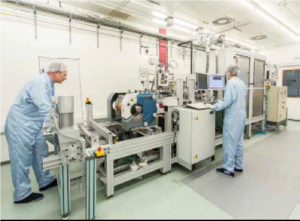 High volume production (> 12.000 m / year) of LED foils for indoor lighting of smart buildings. The LED foils should have an output of 3000 lumen per square meter and a lifetime of at least 50 khrs. Three generations of the showcase are set up to validate the pilot line service:
High volume production (> 12.000 m / year) of LED foils for indoor lighting of smart buildings. The LED foils should have an output of 3000 lumen per square meter and a lifetime of at least 50 khrs. Three generations of the showcase are set up to validate the pilot line service:
- Generation 1: White LEDs on foil for illuminating smart homes and offices
- Generation 2: RGB LED types and white LEDs for scene setting lighting
- Generation 3: Full cover LED wall modules on a large scale
- Demonstrate the LED foil in relevant environment and test it.
Achievements
Generation 1
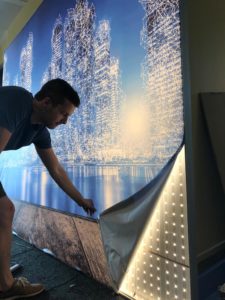 The first generation of the design that defines the fundamental properties of the product was completed just after the first year. Product architecture was prepared by Signify, electrical outline was designed by IMEC and the materials were selected by Holst Centre.
The first generation of the design that defines the fundamental properties of the product was completed just after the first year. Product architecture was prepared by Signify, electrical outline was designed by IMEC and the materials were selected by Holst Centre.
The product design was printed on PET foil by Holst Centre and the nearly 6000 LEDs were assembled on the flexible substrate by CPI. Possible shorts and open circuits were successfully repaired, and after progressing trials these faults were resolved. After production of this roll to roll LED foil, the 30 meter LED foil was cut and installed in a full light box (2.4mx 3m.). Evaluation of the optical performance and thermal behaviour of the product made it possible to perform lifetime modelling studies. Reliability tests performed by IMEC indicated the robustness of the system.
Generation 2
 The first generation had only the function of illumination, while the second generation included scene setting as well. For that next level of lighting, the luminaire contained not only the white LEDs, but also RGB LEDs and controls for the scene setting experience. Consequently, the design of the LED foil became much more complex and with that the second generation was a perfect test to evaluate the technical capability of the pilot line both in design (due to the different power and data lines) and manufacturability (due to the increased number of different components).
The first generation had only the function of illumination, while the second generation included scene setting as well. For that next level of lighting, the luminaire contained not only the white LEDs, but also RGB LEDs and controls for the scene setting experience. Consequently, the design of the LED foil became much more complex and with that the second generation was a perfect test to evaluate the technical capability of the pilot line both in design (due to the different power and data lines) and manufacturability (due to the increased number of different components).
The Signify’s Hue lighting system formed the base architecture of the second generation. IMEC redesigned the 1D Hue LED strip to a 2-dimensional printed electronics design. This complex three-layer pattern was printed by Holst again and they assembled the LEDs and passive components on the foil as well. This LED foil was installed in Signify’s OneSpace luminous box connected with the Hue system.
Generation 3
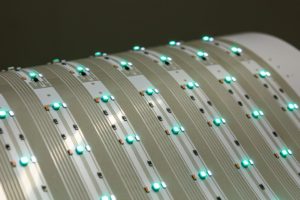 The small light and scene setting box of generation 2 was enlarged to a 2.4×3 meter LED wall. Therefore 300 meters of the complex 3-layer pattern were printed on the foil by Holst Centre on their roll to roll line. VTT assembled approximately 40.000 LEDs and passive components on 40 meters of this foil using their new roll to roll assembly line. The foils were installed together with the drivers and controls at Signify’s premises.
The small light and scene setting box of generation 2 was enlarged to a 2.4×3 meter LED wall. Therefore 300 meters of the complex 3-layer pattern were printed on the foil by Holst Centre on their roll to roll line. VTT assembled approximately 40.000 LEDs and passive components on 40 meters of this foil using their new roll to roll assembly line. The foils were installed together with the drivers and controls at Signify’s premises.
The high level of design and the 3 subsequent layers of printing stacked on each other with connect or isolate functions of each layer provides the capability and capacity of the pilot printing lines. Same applies for the component assembly, the high amount and mix of components assembled, the better industrialisation grade of the pilot assembly lines.
Benefits from InSCOPE
In the electronics production market, there is an important trend away from rigid PCB’s and their traditional way of manufacturing. LED Lighting is getting more and more flexible, adapting more and more to organic shapes.
This requires a new approach in lighting architecture and production techniques. The new manufacturing methods like the once offered by the InSCOPE project give the opportunity to asses new lighting propositions in a fast and agile way. Development, evaluation and introduction of new thin, large lighting system products could be manufactured by the InSCOPE pilot line. The realised showcases as well as testing samples already made in a production like environment are suitable for meaningful function and reliability tests.
The InSCOPE consortium with the pilot line and services offered by the different RTO’s give the opportunity to try out the Printing Electronics technology for lighting products. Especially the wide range of options within the pilot line and the state-of-the-art sheet to sheet printing & component assembly equipment as well as the roll to roll printed electronic lines with accompanying roll to roll assembly lines give the opportunity to explore the technology and possible architectures broadly.
Flexible LED strips will in the future be different from the products available today in terms of dimensions, materials and processing. InSCOPE pilot line gave Signify the opportunity to evaluate these newly designed LED solutions for potentially very large surfaces in an early stage to be the first supplier in the lighting market. The applied technologies in InSCOPE based on mainly roll to roll production gave also a large potential to sensors and controls integration and to cost attractive manufacturing environment, even for small scale product volumes.
And finally, the ‘green’ printed electronics technology showed by InSCOPE can be benchmarked with the wet chemical patterning method.
Bosch
Automotive dashboards – Product idea
 Demonstrating an automotive dashboards application with typical automotive reliability requirements (17 years lifetime, 300.000 km driving distance and 50.000 motor starts) with touch screen interaction experience.
Demonstrating an automotive dashboards application with typical automotive reliability requirements (17 years lifetime, 300.000 km driving distance and 50.000 motor starts) with touch screen interaction experience.
|
|
|
Our Customer
 Bosch is one of the largest Tier 1 suppliers of automotive technology and mobility solutions, it employs a workforce of more than 200 000 in the automotive sector, with a turnover of about 47 bn Euro in 2019.
Bosch is one of the largest Tier 1 suppliers of automotive technology and mobility solutions, it employs a workforce of more than 200 000 in the automotive sector, with a turnover of about 47 bn Euro in 2019.
As a full partner and end-user of InSCOPE, Bosch will be provided with pilot line that will reinforce BOSCH industrial leadership in advanced TOLAE technologies and products addressing high-impact, high-volume applications thanks to integration of touch-sensing and haptic functions with printed hybrid TOLAE technologies.
Aims for pilot line
 Make a future interior with seamless integrated surfaces that should replace mechanical switches and buttons.
Make a future interior with seamless integrated surfaces that should replace mechanical switches and buttons.
- Generation 1: Touch & haptic surfaces with PCB-based driving electronics
- Generation 2: Touch HMI with in-mould OTFT driving electronic
The goal is to integrate the haptic feedback surfaces into 3D-shaped plastic housing with intensive reliability testing. And finally prototype 3D-shaped haptic feedback dashboards into an operational environment (simulation, cockpit, concept car) and benchmark with other car HMI systems in interactive operation conditions.
Current achievement
InSCOPE team progressed with functional part and finalized decoration foil, haptic foil and adhesive. Mould & process validation on an integrated touch and haptic 3D-shaped surface, insuring no shrinkage of graphics and touch & haptic foils.
Functionality at system level was assessed with good results according to end-user requirements for the qualification of the HMI surfaces. The reliability to automotive standards has been evaluated.
Benefits from InSCOPE
InSCOPE introduces novel “Human Machine Interface” solutions that will reduce the complexity of inline assembly and the assembly time for the final installer, as well as the overall weight and cost. This will result in a cost reduction for manufacturers while interaction with the controls will continue being safe for the driver by reducing distraction.
The haptic perception requires quantifying the level of force, amplitude and frequency needed to feel a change in smoothness, a vibration or a virtual button on a sensitive surface. This impression of touch stimuli is addressed by different models for multimodal perception integrating visuo-haptic approaches. Due to the HMI design approach based on plastic foil substrates, the use of electroactive polymers (PVDF derivatives) offers the best compromise in terms of deformation, force, speed and driving voltage.
Development process
“Human machine interface” printed functionalities are fabricated by sheet to sheet transparent touch sensors & haptic actuators layers. These blocks will be either printed in a single foil or heterogeneously interconnected prior to injection into a plastic housing. PCB-based driving electronics will be developed with associated reading & driving software to drive electronics. Thereto, electronics for reading sensors and driving actuators appropriately are created. Below are manufacturing sequences:
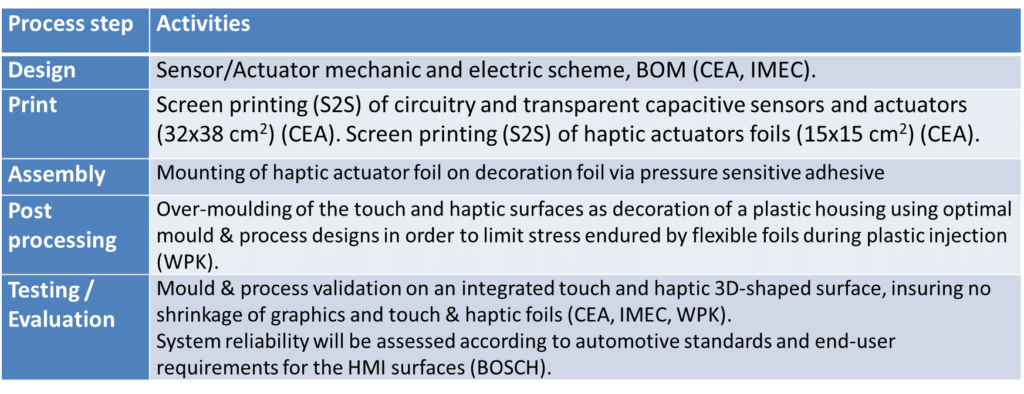
Learning process
The multilayer (decoration foil-adhesive-haptic actuator substrate) generates a bump during moulding. Interconnexion yield on the capacitiv sensors (buttons and sliders) was optimized with enhanced tooling concept. The assembly and over-moulding of hybrid LEDs and flexible OTFT circuits in GEN2 required significant engineering for robust processing.
Possibilities
The basic principle of multiplexing employed in GEN2 could be combined to other mature sensors and actuators technologies when cost and functionality figures make sense. For automotive applications, robustness to environment need to be improved to reach the automotive reliability standards.
KONE
Smart Building – Product idea
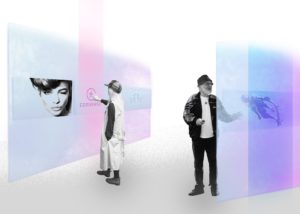 Integrated media surfaces enable digital solutions to become part of the spatial experience and dynamic interior designs. InSCOPE bridges the gap between idea and reality producing the following impact:
Integrated media surfaces enable digital solutions to become part of the spatial experience and dynamic interior designs. InSCOPE bridges the gap between idea and reality producing the following impact:
|
|
|
|
Our customer
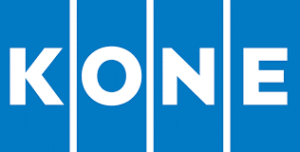
As a global leader in the elevator and escalator industry, KONE provides elevators, escalators, automatic building doors and solutions for maintenance and modernization to add value to buildings throughout their life cycle. The company’s mission is to improve the flow of urban life and vision to deliver the best People Flow® experience.
- Founded in Finland in 1910
- Approximately 60,000 employees
- Approximately 500,000 customers
- Net sales EUR 10 billion in 2019
As a full partner and end-user of InSCOPE, KONE will be provided with an interactive media surface pilot line for quality approval and commercial release as well as for assessing its suitability for professional applications.
Current achievement
Three product prototypes were developed and tested by different users in order to understand their experiences of interactive media surfaces and have their insights into designing them. The emphasis was on multisensory product qualities, which enrich user experience and increase accessibility. A design research approach was adopted, and a case study method applied. Answers were sought for what the appearance- and feel-related possibilities in designing interactive media surfaces are and what kind of multisensory user experience the surfaces can enable.
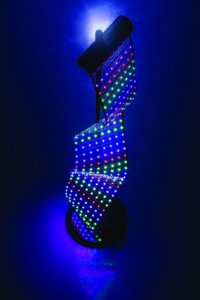
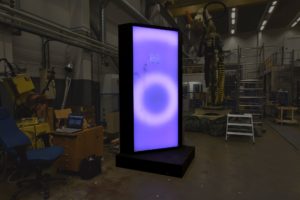
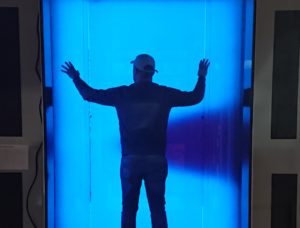
Aims for the InSCOPE pilot line
InSCOPE demonstrated an interactive media surface at low cost in real elevators for KONE. It was set up step by step in 3 generations:
- Generation 1: technical prototype
- Generation 2: interactive media wall
- Generation 3: interactive media surface in an elevator car.
Development process
Based on the KONE key requirements, specifications and product architecture for an interactive media surface and the functionalities, designed and manufactured on a large-area roll-to-roll LED luminaire with packaged LEDs, R2R assembled bare die LEDs, large-area printed capacitive and an individually controllable RGB LEDs 8 x 8 matrix display.
The structure to be developed in InSCOPE was:
- Thin (<1mm) and light (0.25kg/m2) (currently 11 mm. and 3.5 kg/m2).
- Roll-to-roll manufactured (300 mm x 2400mm) flexible and transparent display engines with individual controllable RGBW LEDs capable to drive video and DMX content.
- People detection in elevator with large area capacitive proximity sensors with 1 m detection distance and capability to recognize users, wide area optical sensors for detecting various persons, their gestures and location.
- Integrated, interface with capacitive touch sensors, backlighting and haptic feedback integrated on led foil.
- Internal transparency of 94 % for functional foils to enable a) glass wall integration and b) multi-foil stack product architectures.
- Unique design freedom in large-area walls with alternating/non-fixed LED pitch/patterns/locations and enabling different functional areas (e.g., areas for 1) User Interface, 2) Infotainment, 3) Animated lighting 4) Tunable general lighting)
- Novel plug and play “mother-foil“ with novel foil-to-foil interconnections for power- and signal feeding for functional foils with easy-to-install and easy-up-grade possibility.
- Cost efficiency of the media surfaces by 80 % compared to current reference solutions.
User Studies
In the user studies, interactive media surfaces were viewed as a part of semi-public and public urban spaces, in which technology is embedded. Elevators were an example of them. The aim was to find out how different properties such as interactivity, colours, lights and their movements influence user experience. In interactivity, the focus was on interaction between people and a surface. Insights into designing interfaces that are easy and intuitive to use by diverse people, have an animated and tuneable general lighting and contents that result in positive both personal and collective experience were sought for.
The Generation 2 prototype, an interactive media wall, was tested by students and teachers of architecture, interior architecture, and industrial design. Based on the findings, design drivers for developing the next generation prototype were created. The Generation 3 prototype installed in an elevator car was evaluated by experts by experience in terms of physical and visual impairments. The user study consisted of two parts and utilised multiple methods such as thinking aloud, interacting with the prototype, interviews, and a design game. The prototype portrayed different combinations of colours, lights and their movements. The aim was to receive feedback from diverse users with varying abilities and dimensions. The analysis of the collected material was data-driven.
Findings
Based on the findings of the user studies, interactive media surfaces’ appearance- and feel-related qualities were concluded. Some colour, light and movement combinations induce stronger reactions among users than others and influence the pleasantness of the experience, and usability and accessibility. Depending on the combinations, also various kinds of associations can be created. Based on the findings, interactive media surfaces can have many purposes of use, both utilitarian and hedonic, and locations.
According to the feedback received from users, the most appreciated experience in an elevator car with interactive media surface would be calm and temperate. In order to provide users with such an experience, an interactive media surface should have blue colours, or alternatively tinted yellow, soft contrasts without compromising accessibility, predictable, up- or downward movements, subtle instrumental music, a sensitive enough manual control, voice as a complementary means of controlling the surface, no scent or at the most a subtle one, adjustable settings by users, secured use of private information, and contents based on users’ individual preferences.
Expressing identity, whether the identity of a building, architecture, or a company’s brand, can be seen as one of the key values of interactive media surfaces for customers. Another is wellbeing, which can relate to individual users or the environment at large.
Hybrid TOLAE pilot lines proved to be functional for producing larger amounts of consistent products, which is promising from the concept development point of view. This is valuable for the following projects and is likely to lead to the development of manufacturing lines and foster the development of similar products.
Learning process
Choosing a design research approach and a case study method enabled to gain an understanding of users’ experiences and insights. From such a standpoint, it was possible to aspire findings that could also benefit concept design and strategic development. The notion of user experience helped understand the various dimensions of experience. The findings from the user studies contributed to the development of the prototypes, enhanced empathy towards users, and provided design drivers for developing similar products in future.
By exploring different interactive means, the conventional limitations of users’ relation to space were stretched and different UI functionalities than the operating elevator movement considered. Some of the assumptions turned out to be too far-reaching in terms of the current realisation possibilities, but envisioning concepts for the future were aimed at.
Benefits from InSCOPE
The strength of the InSCOPE pilot line service lays in the co-operation between the RTD partners, enabling industrial partners and end-users to request the most advanced demonstrators by selecting from a large pool of manufacturing routes and functionalities spanning over different institutes. This ensures that end-users can expect an optimal output with respect to costs, reliability and performance. By offering this extensive combination of state-of-the-art processes and functionalities from all participating partners, InSCOPE is the most comprehensive hybrid TOLAE enabled pilot line service to date related to relevant printing techniques, hybrid integration methods and product integration techniques.
Interactive media surface
Media surfaces in general are a potential means of displaying content that could interest and engage users. New technologies, such as hybrid printed electronics, can offer a cost-efficient and an environmentally friendly way of realising them. The currently available products are mostly displays and façades that are mainly used for advertising, informing, and communal purposes of use like art. From users’ viewpoint, they do not seem to be appealing and motivating enough to engage in interaction. They tend to remain unnoticeable and using them can be experienced as embarrassing. Therefore, new content possibilities need to be explored.
When it comes to elevators, media surfaces are a step towards intelligent building materials. They can offer flexible possibilities to modify the elevator car appearance, instead of changing wall materials. They enable products to be seamlessly integrated in the building architecture and updates made according to the building’s lifecycle.
KONE interactive media surfaces
“Media surfaces, when used as part of architectural environments, have gradually changed to become highly integrated solutions. Media architecture has become one of the most current and recognized fields of urban planning and architecture. KONE is known for being a people flow solution provider and we see that these large media surfaces will be an integral part of future urban spaces and urban living.
Integrated media surfaces enable digital solutions to be part of the spatial experience and dynamic interior designs. We are developing intelligent wall materials, rather than simple display solutions. We are also looking for large scale production, and the InScope project is a fantastic opportunity to study, learn and share the needs and possibilities for these technologies.
A major benefit of InScope is to add interactive features and functions into media surfaces. For example, hybrid TOLAE capacity provides the possibility to remarkably reduce manufacturing costs and material needs for large scale solutions. The KONE media surface has been developed to be seen from short distances which sets out special visual requirements for our solutions.
From a functional point of view, digital content enables flexibility in terms of visual appearance, intuitive guidance and usability. The KONE media surface interior is something to experience rather than being simply a display to watch.
In InScope project we wanted to research and study different means of interaction; functional, almost user interface like concepts (Gen2) and more expressive (Gen3), even more user experience driven consepts that even more challenged conventional solutions. From the technical point of view they enabled us to research different solution methods, some more integrated to foil challenging their limits expecially in terms of transparent tracking etc., some more related to spatial AI enabled optical sensors.
In general I see InScope project as important enabler for valuating non-conventional product design possibilities and manufacturintg capabilities for KONE not only in certain product scope, but also widely in various product lines. Participating this kind of projects also means possibility in following and commenting technological research needs and business insights for new manufacturing methods. From product development point of view hybrid TOLAE capacity provides flexibility.”
Jukka Korpihete,
Experience design, Expert, KONE
User Experience
User experience consists of various dimensions that relate to a product, its user, and the context of use. A product’s usability, appearance and semantic qualities, the cultural context as well as a user’s identity all contribute to how a person experiences a product and feels when using it. User experience is thus shaped by many intertwining factors, of which some can be influenced by means of design. Designing for user experience requires understanding how different qualities of a product, for example, an interactive media surface, influence the user experience.
Sustainability
Sustainability is an integral part of our business. Media surfaces are products, in which energy efficiency and efficacy are fundamental for the whole concept creation. Low density led matrices are roughly 20% more efficient than led display tile based or display based solutions that are widely used in similar cases. The recyclability of material resources is also part of the concept development evaluation and reasoning.
